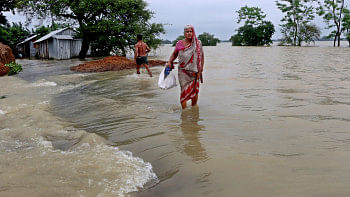Can ‘engineering diplomacy’ solve Bangladesh-India water issue?

Bangladesh is still recovering from the devastating August 2024 floods, one of the worst regional floods in its history. Millions were displaced, livelihoods shattered, and diplomatic tensions reignited. Yet, this crisis could be the turning point for regional cooperation.
The science and misinformation of the floods
The floods were driven by intensified monsoon rains, a shifting jet stream, and the Madden-Julian Oscillation funnelling moisture into south-eastern Bangladesh. Districts like Feni and Noakhali, areas not typically prone to severe flooding, experienced record-breaking rainfall and devastating impacts—half a million displaced, over 300,000 hectares of farmland submerged, and schools and roads left in ruins.
But alongside the rising waters came a surge of misinformation. Social media was rife with accusations that India had released water from upstream dams to worsen the floods in Bangladesh—a narrative fuelled by decades of mistrust over water sharing. While these claims were scientifically questionable, they complicated mitigation efforts and strained relationship between the two neighbours.
Addressing natural calamities requires more than just technical fixes—it demands an understanding of the social and political narratives that shape perceptions and responses. This is where engineering diplomacy can play a transformative role.
Engineering diplomacy: A bridge between science and society
Engineering diplomacy offers a pathway forward. It synthesises scientific facts ("numbers") with cultural and political contexts ("narratives") to create solutions that are technically defensible, societally acceptable, ethically responsible, and politically feasible. Rather than framing the floods merely as a natural disaster or a political weapon, engineering diplomacy would encourage both nations to explore shared interests. Bangladesh's vulnerability to extreme weather and India's role as an upstream actor are not mutually exclusive—they are intertwined challenges that demand shared solutions. By moving from positions ("India must release more water") to interests ("how do we ensure equitable water availability?"), engineering diplomacy fosters trust and pragmatic problem-solving.
What Bangladesh and India can do together
The 2024 floods underscore the shared stakes for both nations. India, too, faced devastating floods in upstream regions like Tripura and Bihar highlighting how interconnected the challenges are. Recognising this shared vulnerability, Bangladesh and India can take specific steps towards resilience and cooperation:
Initiate a "devising seminar" for shared resilience
The two countries can convene multi-stakeholder workshops with representation from four critical communities from Bangladesh and India—knowledge, political, resource, and affected—which can create a platform for collaborative problem-solving. This informal yet structured dialogue can focus on key areas like real-time data sharing, joint flood forecasting systems, and equitable water-sharing protocols for transboundary rivers such as the Feni and Gomti. I have discussed details of a devising seminar in an earlier piece for the Himalayan rivers. We need informed conversations to hammer out the details required to act and move forward on how to develop and share transboundary resources for an equitable and sustainable future. Complexity of transboundary issues demands learning from other river basins like the Nile, Jordan, and Danube—and adapting to local situations.
Strengthen public perceptions against misinformation
Debunking misinformation and conspiracy theories during a disaster usually does not work. Countering misinformation isn't just about presenting facts—it's about addressing the fears and mistrust that fuel these narratives. Within the context of current Bangladesh-India relations, these narratives are not surprising.
Collaborative projects that are responsive to the underlying interests—not positions–of both parties may be an effective way to ease these tensions, lessen misinformation virality during future floods, and make practical progress on flood resiliency challenges. For example, statements that simultaneously acknowledge that Bangladesh has legitimate fears of water control by India while being clear that the evidence in this particular case does not suggest India's political interference could go far to debunk conspiracy-inspired narratives. As a proactive measure, both nations can launch joint public communication campaigns now to start developing trust in the information they share. By aligning messaging with scientific findings and cultural sensitivities, these campaigns can build trust and reduce the likelihood of misinformation inflaming tensions when the next flood hits the region.
Reactivate collaborative institutions
The Joint River Commission between India and Bangladesh offers a formal venue for cooperation but has been largely inactive. Reactivating its subcommittees, particularly the Indo-Bangladesh Experts on Flood Forecasting and Warning Systems, could reinvigorate bilateral efforts. This subcommittee has not met since 2004.
Demonstrate collaboration through pilot projects
Pilot initiatives such as joint construction of flood-resilient embankments or shared water-storage facilities for the Feni and Gomti rivers can demonstrate the benefits of collaboration. In addition, establishing a shared platform for real-time data exchange on rainfall and river flows to improve flood forecasting accuracy and initiating joint training programmes for disaster response teams to equip them with advanced tools and techniques for flood mitigation can serve as examples of tangible steps forward. These projects will turn shared challenges into opportunities for cooperation.
Expand collaboration beyond water
Collaboration doesn't have to stop at rivers. To develop actionable strategies, a different approach that goes beyond water and includes a package of mutually beneficial options is needed. For example, joint solar parks and renewable energy projects can reduce energy insecurity on both sides. The inclusion of Sundarbans—as perhaps the only transboundary ecosystem that has a World Heritage site and Ramsar site on both sides of the boundary—within the upcoming 2026 Ganges Water Treaty negotiations can serve as an example of how to operationalise engineering diplomacy processes and tools for effective transboundary water cooperation. We need to look for opportunities to engage affected groups in value-creating exercises before final decisions are made. This will encourage issue and option linkages and increase opportunities for meaningful negotiations. Seeking broader consensus (total unanimity is not essential) and relying on professional neutral facilitators is likely to help formulate nearly self-enforcing and easier to get compliance agreements.
Shafiqul Islam is director of Water Diplomacy, professor of civil and environmental engineering and water diplomacy at the Fletcher School of Law and Diplomacy at Tufts University, US.
Views expressed in this article are the authors' own.
Follow The Daily Star Opinion on Facebook for the latest opinions, commentaries and analyses by experts and professionals. To contribute your article or letter to The Daily Star Opinion, see our guidelines for submission.

 For all latest news, follow The Daily Star's Google News channel.
For all latest news, follow The Daily Star's Google News channel. 










Comments